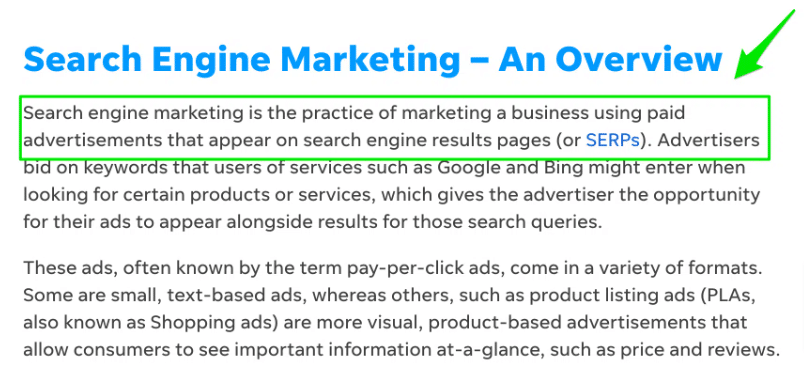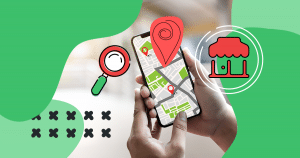The internet is a beautiful place packed to the brim with information and cat videos.
The sheer size and scale of the internet are immense and almost incomprehensible. But the internet is more than a safe haven for adorable puppy videos and tutorials on how to boil water: it is any company’s marketing dream come true.
On a single platform, companies can connect with millions of people. They can communicate and share their messages effectively.
Companies have swarmed the internet in recent years to take advantage of this, a strategy known as Digital Marketing.
Now you may have heard of Digital Marketing along with various other hype words in seminars and other marketing-related events.
As much as you may not want to believe them, people overhyping the effectiveness of Digital Marketing are often right.
If you have been hesitant about using Digital Marketing, it can be overwhelming. This post will help you slide right into the scene.
This guide will go over:
- What is Digital Marketing?
- The Importance of Digital Marketing
- Benefits of Digital Marketing
- The Difference Between Direct and Digital Marketing
- How to Do Digital Marketing?
- Essential Digital Marketing Terminology
- Digital Marketing Approaches For Each Stage of The Buyer’s Journey
- How to Create a Digital Marketing Strategy in 6 Steps
- 14 Best Digital Marketing Strategies
- Digital Marketing Examples
- How B2B And B2C Companies Can Use Digital Marketing Strategies
- How to Measure Digital Marketing Success
- Popular Digital Marketing Tools
- What Does a Digital Marketer Do
- Digital Marketing Services
- [BONUS] The Basics of Digital Marketing For Beginners — A Summary of The Main Points
- What Is Digital Marketing FAQ
- Wrap Up
What is Digital Marketing?
Digital Marketing is any marketing efforts that rely on electronic devices, and the internet.
It’s the group of activities that a company or individual performs online. These activities attract new business opportunities, create relationships, and develop a brand identity.
From this Digital marketing definition you can understand that Digital Marketing is very diverse and versatile.
The sheer amount of tools, data, and channels available on the internet creates opportunities for marketers to deliver effective content to specific people, through personalization.
Are you looking for a more direct advertising strategy for a very particular audience, that will help your brand to grow?
Well, Digital Marketing strategies like using emails or ads in specific social media groups can attract a very niche audience. They deliver a tailored message based on their specific interests.
Are you looking forward to advertising your company to a mass market, garnering massive appeal and brand awareness?
Video ads and regular ads on social media applications and search engines should put your brand in front of millions of people.
Regardless of your audience type or how niche your product may be, there’s a way to reach them.
The Importance of Digital Marketing
By now, it might seem impossible that the number of global internet users is still steadily climbing, but that’s exactly what’s happening. According to recent research, there were approximately 5.4 billion web users worldwide in 2024.
That represents 66% of the global population. And, of course, those numbers have only continued to rise since and will do so into the future as more and more people get online.
Those statistics combined with the way the internet has already changed how people shop make digital marketing more essential than ever.
Successful marketing today involves reaching your target audience where they live and at the right times. Your customers are spending increasing amounts of time on social media, searching for information on search engines, and just being online in general.
That said, online digital marketing isn’t just a good idea anymore. It’s an essential part of any comprehensive marketing strategy. Because without it, it’s just about guaranteed that you’re missing out on valuable business.
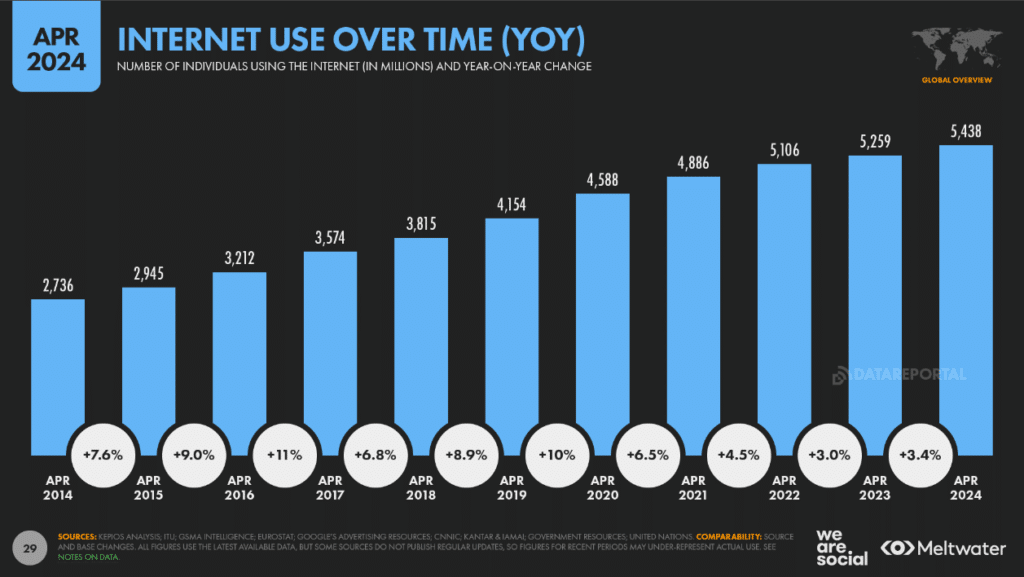
Why Your Company Needs Digital Marketing
Digital marketing has been hailed as a game-changer for good reason.
It offers a singular platform where businesses can tap into an endless stream of information, leads, and potential customers.
Ignoring digital marketing means missing out on one of the most lucrative marketing avenues available today.
In essence, the internet is the primary driving force behind this necessity.
With billions of users online daily, digital marketing provides unparalleled reach and engagement opportunities that traditional methods simply cannot match.
The current digital marketing landscape
The online world allows brands to communicate with all of their clients and possible clients. You don’t even need to be in the same country to find and engage your public.
Technology has transformed simple phones, originally designed to make calls, into true computers. These provide all the access users need to connect with others. Apps, emails, and websites are literally in the palm of their hands.
Smartphones are incredibly popular, especially among Millennials and Generation Z. Applications like Instagram, Facebook, and TikTok occupy hours of their day. Companies have thus found a direct link to their lives.
Facebook, a very famous social media site, has over 2 billion users. It is a popular choice among companies to market their products. Instagram, LinkedIn, TikTok, and all social media can be beneficial to your business depending on your goal and audience.
With such a massive reach, advertising for companies is often like shooting fish in a barrel.
Benefits of Digital Marketing
Digital Marketing is one of the most powerful marketing tools for any company to use. And to prove our point, here are some of the benefits of using Digital Marketing.
1. The most measurable form of marketing
Let’s start with what is possibly the most obvious benefit of using Digital Marketing: you can track it.
We all know that to ensure a marketing strategy works, we must track its success over time. The internet’s reliance on numbers and algorithms makes it easy to monitor how effective a strategy truly is.
Although that may be a little difficult with more traditional mediums, it is very simple to measure the effectiveness of a strategy with Digital Marketing.
Digital Marketing analytics takes away the guessing games related to traditional forms of marketing.
Through these analytics, you can measure in real-time how many people are looking at your posts or ads, as well as how many users have opened your posts, along with all the people who have replied, liked, or shared your post.
2. The most cost-effective marketing technique
Other than being able to track all of your posts, along with all the likes, comments, and shares that it receives, it is also the most cost-effective marketing technique.
Now, it is important to note that Digital Marketing is comparatively cheaper than most traditional forms of marketing.
While there was once a paywall between major companies and smaller ones in terms of advertising and exposure, that is no longer the case. Nowadays, smaller companies can get the attention of people that they otherwise could not.
Competing with bigger companies for the ad space in most forms of traditional marketing can be almost impossible for smaller businesses.
This is something that they can cover with the help of Digital Marketing, as they can reach an audience of their choice with minimal effort.
3. Allows you to choose any audience
Speaking of choosing your audience, another great benefit of Digital Marketing is that it can be as specific or broad as you want.
You can find specific groups or forums on social media websites like Instagram or Reddit to market to a very niche audience.
You can also market to a very broad audience through internet ads or sponsored posts on Facebook and Instagram. No matter who your target demographic is, you are sure to find them through Digital Marketing.
Other than directly marketing to your audience, you can also make use of influencer marketing, which allows you to directly tap into a specific market through mediators and familiar faces.
Sometimes influencers need the support of sponsors, and to help them, users will often follow the links they provide.
Moreover, getting a respected figure in the community you are tapping into can grow trust for your brand.
4. Everyone is already there
A common problem that people face with traditional forms of marketing is the question “Will anyone see it?”.
Most crowded places in the city are very expensive to rent. With Digital Marketing, you don’t have to worry about such a thing.
With billions of people using the internet and social media daily, the question is no longer will anyone see it, but rather when.
Print ads and other forms of traditional advertising also have a limit on just how many people they can reach.
No matter how big the network might be, there is a cap on just how many people a traditional marketing strategy can connect to.
On the other hand, Digital Marketing strategies have no peak of exposure and can grow along with the company itself.
5. Customers start their buying journey on the internet
Customers depend on the internet for everything, including their buying options and choices.
For more and more customers, the buying journey starts with research and insight into the product or service. What better place to find out more about something than the internet?
Since the term “Google it” has become such a common part of our language, the first instinct of most people is to search for something on the internet.
A study published by Orbelo in 2019 registered that 85% of shoppers consult the internet on purchases they are about to make.
That is the goal of designing a great Digital Marketing strategy: you can be the answer that these people are looking for.
6. The message can be customized
Another big advantage of Digital Marketing is that this strategy allows you to customize your message to the public.
Advertising today is different from the old days. Back then, when you wanted to talk to you public, you needed a generic message, that could be used in mass media such as billboards, TV broadcasts, flyers, etc.
The conversation with the public was not so effective, once you were talking to people of different genders, ages, and interests.
Now, you can target groups by their similarities, customizing the message and making it more real and directed to them.
Email marketing, online advertising, niche marketing: all of these strategies can be customized to reach the audience that you want.
The Difference Between Direct and Digital Marketing
Both direct marketing and digital marketing are forms of targeted advertising. However, while they can work together nicely, they are very different from one another.
Direct marketing is a form of traditional offline marketing that involves advertising a business, product, or service via physical materials like mailers, brochures, coupons, and pamphlets. Direct marketing materials can be helpful if your representatives ever need to present something physical to customers they interact with.
Meanwhile, digital marketing aims to reach people via social media, search engine optimization, content marketing, and similar tactics.
Online Marketing vs. Digital Marketing
Although people tend to use the terms “online marketing” and “digital marketing” interchangeably, the two are not the same. They are, however, connected, and digital-age marketers and brand reps need to be familiar with both.
Any type of marketing content that involves electronic devices counts as digital marketing. Online marketing, on the other hand, is actually a subcategory that covers marketing content delivered or published specifically through the internet.
In other words, all online marketing is also digital marketing and includes content marketing, SEO, email marketing, and more. However, digital marketing is a larger umbrella term that also covers marketing options like digital billboards, radio or television ads, and SMS advertising.
Inbound Marketing vs. Digital Marketing
Although you may occasionally see the terms “digital marketing” and “inbound marketing” used interchangeably, it’s essential to understand they’re not the same thing.
Digital marketing is a much more general term that applies to any marketing tactics involving digital media, platforms, or communication methods.
That said, inbound marketing is a type of digital marketing, especially as compared to outbound marketing.
Outbound marketing is probably what you think of when you picture a more traditional marketing approach. Think of marketing tactics that attempt to reach as many people as possible, regardless of whether they’ve shown interest in the advertised product.
Examples include offline approaches like trade shows and cold calls, as well as online tactics like old-school banner ads and untargeted email blasts.
On the other hand, inbound marketing is about focused strategies designed to reach an ideal audience of potential customers.
These are people who have either shown active interest in the type of solution being sold or are struggling with pain points the solution could address.
Inbound marketing content is designed to be helpful, entertaining, or otherwise valuable to this audience.
Popular examples of effective inbound marketing techniques include subject-specific blogs, ebooks, videos, social media posts, and web-based seminars.
How to Do Digital Marketing?
Creating an effective digital marketing strategy isn’t just a must in today’s increasingly web-based world. It’s easier to do than you might think, even if you’re brand new to the game.
Here’s a look at how to get started.
Set clear goals and objectives
Without a clearly defined goal, a digital marketing strategy is nothing more than a shot in the dark that may or may not hit the target.
So start your journey by figuring out what your goals are because they will be the focus of all your future efforts.
Keep in mind that solid goals are never vague. They’re not only reachable and specific but measurable.
Otherwise, you can never be sure you’ve even made progress toward your goal, let alone reach it.
Build your customer personas
In the past, all a digital marketer needed to create a solid campaign was enough information and collected data about their target demographic. (Think of details like age, gender, location, interests, or profession.)
But these days, your strategy really isn’t complete until you also have a set of buyer personas in your corner.
Buyer personas are semi-fictional identities representing one or more of your desired customers.
They make it easier for marketers to put themselves in the customers’ shoes and are best created by interviewing actual members of the target group.
If you don’t know where to start, the AI Persona Builder by Rock Content can aid you with that.
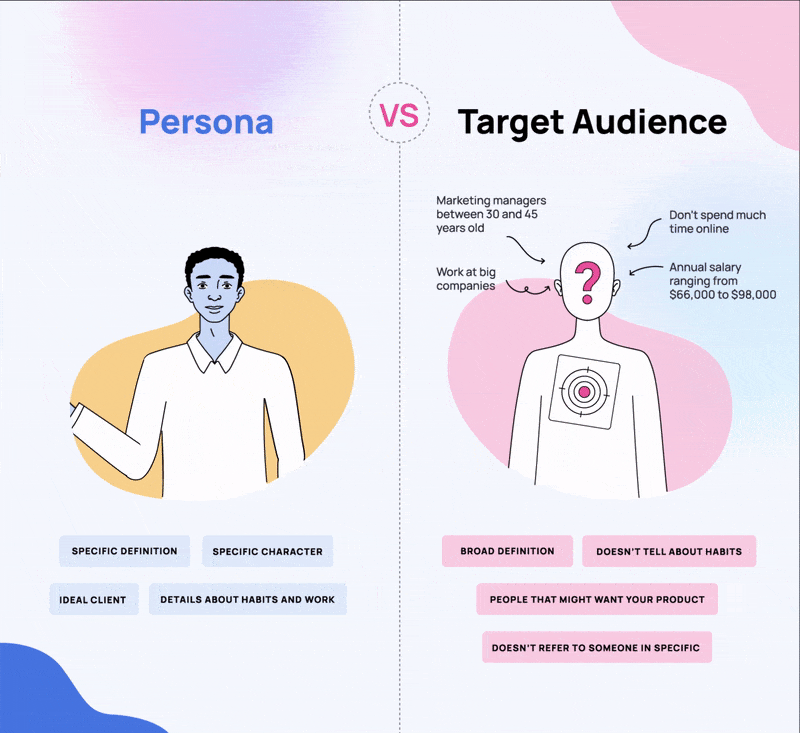
Conduct ongoing keyword research
Thorough ongoing keyword research is at the heart of any good digital marketing campaign.
It’s how you know what your target audience is out there searching for, so it’s naturally also the key to obtaining top ranking on Google, Bing, and the rest of the search engines.
Keyword research is an essential part of optimizing your social media marketing campaign, as well.
Start the process by choosing a keyword research tool that appeals to you and building a running list of options. Include both high-performing keywords and clever long tail alternatives to expand your potential reach.
Create and maintain a blog
Content marketing is one of the most important aspects of digital marketing today, and a blog is one of the most effective tools you can have in your corner.
Adding a blog to your company website gives you a terrific way to boost your site’s SEO and attract interested consumers to your site in the first place.
Set a content production schedule for your blog and stick to it, so your audience knows when to expect new content from you.
Fill your blog with content your target demographic would find useful, helpful, entertaining, or just plain interesting.
Think industry news and answers to burning questions someone shopping for products like yours might have.
Add variety with an omnichannel approach
Competition is fierce these days, so it’s crucial that you leverage your creativity to make your marketing material unique, engaging, and exciting.
Innovate using an omnichannel approach to digital marketing, learn where your target audience spends the most time, and meet them wherever that is.
And although written content is still the mainstay of a good content production effort, it’s far from the only type that yields results these days.
Modern consumers respond to dynamic imagery and exciting interactive content options, so be sure to include options like infographics, videos, professional-level images, eye-catching designs, etc.
Be open to diversifying your marketing strategies, as well, especially when looking to tap into brand-new demographics.
Energetic, clever marketing material and timely, helpful content that’s in step with a market’s current interests and concerns are crucial to meeting your marketing goals and growing your customer base.
Optimize for mobile
Another critical factor to keep in mind when putting together a digital marketing campaign is how prevalent the use of mobile technology is today.
Mobile devices are no longer just items people occasionally use to shop, consume content, or search for information.
According to research by Dynamic Yield, 76 percent of modern consumers say they prefer mobile shopping because it saves them so much time.
That means you’re losing a lot of potential business if your website and content aren’t optimized for mobile use.
So if your site isn’t mobile-optimized, change that as soon as possible. And if it is optimized, go over your current mobile-responsive web design, go-to email templates, and so forth to ensure they’re in step with the latest standards.
Make yourself available to your customers
It’s no longer enough to simply add a contact page with your email address and phone number to your website and call it a day.
Today’s consumers expect a more intimate connection with the companies they do business with.
Your customers need to feel like you’re not just reachable but genuinely available, and it’s vital to meet this expectation.
Make sure your website’s contact page is complete and easy to find. Your landing pages should be clear, concise, and free of any requests for unnecessary information.
Calls to action should be highly visible and crystal clear. Guarantee that your customers know they can reach you on social media, as well, and always respond to questions, comments, and messages in a timely manner.
Distinguish yourself from the competition
Although the digital market is filled with opportunities for great companies to connect with the right audience, there’s a lot of competition out there, too.
And your competitors have more in common with you than you think. They’re selling similar products with similar selling points, and they’re certainly looking to sell to the same demographics you are.
If you’re not standing out from the rest of the crowd, you’re bound to get lost in the shuffle.
So consider what makes your company different. Maybe you offer more variety in your catalog than your competitors do.
Perhaps your products are more reliable, more efficient, or better suited to a particular type of customer than anything else out there.
Do some research to confirm your differentiating factors and make them the focus of your digital marketing campaign.
Be creative, get personal, and always keep your eyes open for ways you can connect on an even deeper level with your customers.
Keep track of your results
No digital marketing campaign is complete without an airtight plan for gathering and analyzing data, so be sure to monitor your progress on an ongoing basis.
The sooner you can determine whether an approach is working, the sooner you can correct anything that isn’t working as it should.
Celebrate successes, but learn from failures. And don’t forget to gather and consider customer feedback as part of your process.
Ultimately, your customers’ responses to your marketing efforts are the most telling of whether they’re working.

Essential Digital Marketing Terminology
There’s a lot of information online covering every single aspect of digital marketing. However, to understand what it means, it’s helpful to get to know some terminology first.
Marketing terminology isn’t complex. Go over the following list a few times, and you’ll get the gist. You may even get ideas for ways to improve your digital marketing efforts.
Without further ado, here are some of the main digital marketing terms you need to know about.
A/B testing
A/B testing means comparing two digital ads promoting the same product. Marketers use this tactic to find the best font, keywords, landing page links, and more. A/B testing can also be used to choose site keywords and design email marketing campaigns.
Brand positioning
Brand positioning means creating a voice, brand colors, and logo to stand out from the competition. It also includes the core values that make your business exceptional.
Conversion rate
The percentage of consumers who complete a desired action on your site represents your conversion rate. The task could be making a purchase, signing up for emails, or liking and following you on social media.
Conversion rate optimization
This term refers to improving your conversion rate to increase the number of people buying goods or services from your website. It’s also known as CRO. It’s one of the best ways to improve results without spending more on digital advertising.
Cost per acquisition
Cost per acquisition (CPA) is also known as customer acquisition cost (CAC). This indicates the amount of money you spend on acquiring a new customer.
Cost per click
Cost per click (CPC) is one of the most common pricing standards for online ads. As the name implies, you only pay when someone clicks on one of your online ads.
Cost per thousand
Cost per thousand is better known as CPM. It’s another pricing standard for online ads. It means you pay a set amount for every 1,000 people who view one of your online ads.
Click-through rate
The click-through rate (CTR) is the percentage of people who view your ad and click on the link.
Data-driven marketing
Data-driven marketing is a marketing plan based on information you’ve gathered from interacting with consumers. Your website stats and digital marketing stats are good sources of data. You can also use information you’ve collected from offline marketing efforts.
Engagement rate
Your engagement rate tracks how many people take action based on your digital marketing efforts. It includes not just sales but also likes, follows, and site views.
Lead generation
Lead generation means providing users with helpful information in return for their personal information. You can use it to identify and get to know your target audience. It’s also valuable for creating a data-driven email marketing campaign.
Return on investment
Return on investment (ROI) is the calculation showing the profit you earn for every dollar you spend on digital marketing. It can be calculated using this calculator:
[ion_script src=”https://ionfiles.scribblecdn.net/scripts/ionizer-1.4.2.min.js” hash=”eyJ1cmwiOiIvL2ludGVyYWN0aXZlLnJvY2tjb250ZW50LmNvbS9lbi9ibG9nL3JvaT9faW9uX3RhcmdldD1lbWJlZC0xLjAiLCJpZCI6Il9pb25faW9uaXplcl8xNjk3NDg2ODExOTMyIiwiZnVsbFNjcmVlbiI6ZmFsc2V9″]
SEO
SEO stands for search engine optimization. It’s a term used to describe the process of boosting your site’s standing with Google.
There are many aspects of SEO. That’s because Google considers many factors when determining your site’s rank. Common SEO tactics include keyword selection, content creation, link building, boosting site speed, and ensuring your site is mobile-friendly.
Target Audience
Your target audience (or target demographic) is the group of people most likely to buy something from you. It could be people of a certain age, gender, ethnic group, or socioeconomic status. It’s also possible to have more than one target audience.
Digital Marketing Approaches For Each Stage of The Buyer’s Journey
The buyer’s journey is the active research process a potential buyer goes through leading up to their purchase.
It follows them through four stages: becoming aware of a need, considering different solutions to fulfill that need, making a decision between the different solutions and becoming loyal to a brand.
The buyer’s journey is a very intricate process filled with doubts and many hassles for the customer.
To help your customers make more educated decisions through every step of the buyer’s journey, here is a small guide to what is relevant and engaging content at each of the steps.
Stages of the buyer’s journey
To better understand the different types of content that you should use through every step of the buyer’s journey, we will go over each step of it and the solution that you can use.
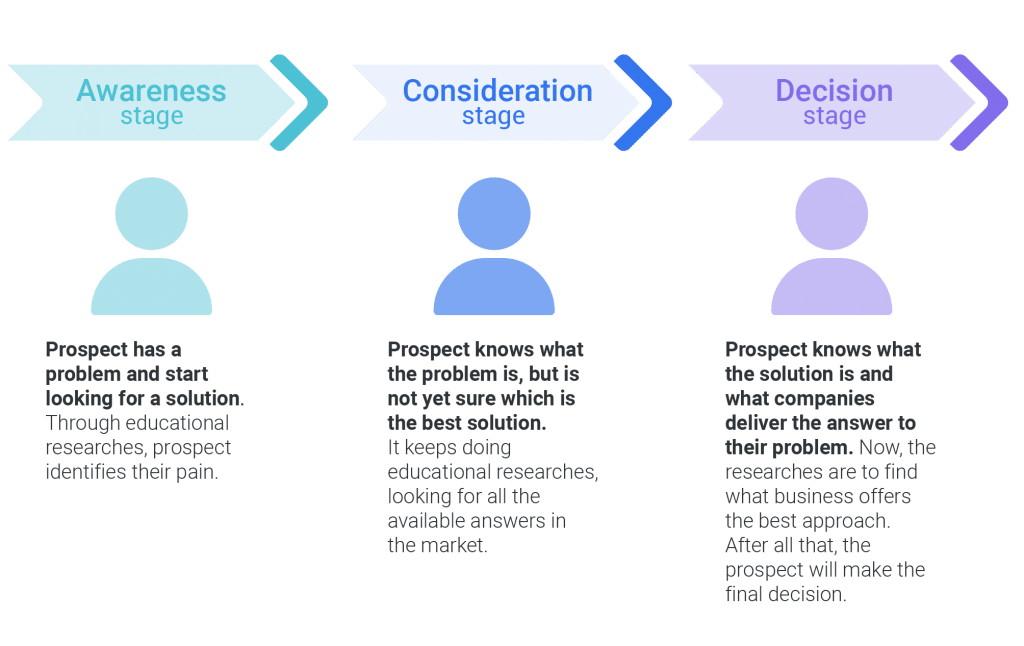
Awareness
Awareness is the first step in every buyer’s journey, as they start to identify the problem that they are facing and the possible solutions to it.
This step often includes extensive research by the customer, as they are not quite sure what they want.
So, this is where you step in to help them make a much smarter decision.
Since your customers will be researching the problem, they will need content that is precise and helps them better understand their situation.
You can provide them with this information through various social media posts, research studies, eBooks, and even blog posts, among other things.
Of course, your priority in each of these cases should be to inform your customers of their situation, and not sell your product or service.
You must give the impression that you genuinely care about your audience, and this content is less like marketing a product and more like informational content.
Consideration
Consideration is the next step in the buyer’s journey, and by now they have graduated to buyers that know the solution to their problem.
That means they are now looking for sellers that can provide them with solutions. In this case, the buyer may know about your company but are looking at other options, or may not know your company at all.
For the buyers that got into the consideration stage, you will have to change the perspective of the content as well as the type of content that you are sending their way.
While in the awareness stage, you were referring to people that did not know much or anything about the source material, here your target audience knows what they want and is now looking for potential opportunities.
You will have to use videos, comparison papers, case studies, and expert guides to explain the best options.
Decision
The time has come. These customers are now willing to buy a product after doing plenty of research on its utility and more.
But now they are not just searching for products; they are looking for companies and brands that are willing to offer what they want.
Here you can take a more advertising approach to your customers so they can buy your products.
You will have to use content that represents perfectly your brand and the personality around it.
Content that works well with this specific step in the buyer’s journey are testimonials, product comparisons, product demonstrations, and even product reviews.
These types of content can be very effective in convincing your audience to get your product because of its unique selling point.
Loyalty
Once the customer purchases a product from you, this is a big win, especially with all of the competition in the market. However, your marketing to them does not end with their transactions.
In fact, this is the start of a new type of content marketing that will entice them to come back and make another purchase.
Indeed, some businesses do not follow up on their old customers, but these are often bigger companies like Amazon or Steam.
These larger companies have such a dominant market presence; it is often more convenient for customers to shop there exclusively.
On the other hand, smaller companies have to rely on these marketing techniques to make sure their older customers come back to the shop.
Moreover, keeping in touch with your customers after their initial purchase is a great way of showing that you care.
This care can generate loyalty among buyers, making them more compelled to spend on your site.
How to Create a Digital Marketing Strategy in 6 Steps
The term “digital marketing strategy” refers to any marketing technique or approach that leverages the effectiveness of various online resources to reach a target audience.
The right digital marketing strategy plays a key role in a company’s ultimate profitability and success. Successful strategies invariably encompass both the values of the desired customer and the end goals of the business.
Knowing you need an effective digital marketing strategy in your corner is one thing, but actually creating such a strategy is another. Here are the key steps to keep in mind:
1. Do current market research
It’s important not to simply assume you know what your target consumer wants. Even if you knew months or years ago, a lot may have changed in the meantime. So always start every new digital marketing strategy with a round of fresh research.
Try using the SWOT method to get to the bottom of things. SWOT stands for strengths, weaknesses, opportunities, and threats – all key factors to identify and assess before moving forward.
2. Clearly define your goals
Before you can reach a destination, you need to identify it, and this is just as much the case with online digital marketing as it is with anything else.
What are you hoping to accomplish with this strategy? How will accomplishing those goals help you realize your larger business objectives?
3. Know who you’re marketing to
Not everyone out there will be a good fit for your company’s services and products, so it’s important to make your efforts count with proper targeting. Developing well-rounded buyer personas based on your market research can help with this.
Buyer personas can help marketers and content creators better visualize their target customers, the better to tailor their efforts to match.
4. Take a closer look at your assets
Once you know who you’re marketing to and what you want to accomplish, you’ll want to decide how and where to do your marketing. Start with a careful assessment of the various assets you already have in your corner. Examples may include:
- Owned media assets, such as your website, your branded imagery, your social media presence, and any original content you may have created
- External digital assets that your marketing team has earned over the years, such as guest content on other brands’ websites or user-generated content
- Digital assets you pay for, such as pay-per-click advertising, sponsored postings, and more
From there, decide how each of these assets fits into your larger strategy.
5. Set a schedule
Consistency is one of the most important factors in the success of a digital marketing strategy. While great content and clever marketing techniques are helpful, they’re not enough to get you there all by themselves. Marketing efforts need to be timed correctly and delivered consistently.
Come up with a schedule you’ll follow for developing, posting, and promoting new content. Do the same with key tactics like link outreach and progress audits, as well. Then stick to that schedule religiously moving forward.
6. Keep track of your efforts
Every marketing strategy should be based on what you’ve learned from previous strategies, as well as ongoing market research and feedback analysis. But if you don’t keep track of your efforts and their results, there will be no data to refer to in the future.
So, track every change, stage, and step when it comes to your strategies. Analyze the results. Then use what they teach you to make future campaigns even more effective.
14 Best Digital Marketing Strategies
Now that you have a deeper understanding of Digital Marketing and how it is important for your company, we can move on to marketing strategies.
There are various types of Digital Marketing, each aimed to help a company in a specific area.
Each type has a different objective and is based on specific channels. It’s really important to mention that they are not mutually exclusive.
Every company, before starting its marketing, has to come up with a proper marketing strategy.
A marketing strategy often consists of all sorts of planning, from the financial side of marketing to the more intricate planning of software that they will use.
A good Digital Marketing strategy can go a long way in getting your company and brand the attention that it needs.
Choosing the right Digital Marketing strategy can be very difficult, seeing how each of them has its specific utility as well as its downfalls.
Therefore, if you are wondering what some of the best marketing strategies to use are, here is a list of the most effective Digital Marketing strategies for any company.
#1. Social media marketing

Social Media Marketing is possibly the most popular Digital Marketing trend of the current generation. It can be very hard to ignore the sheer force that social media has become over the past decade.
Social Media provides a new level of engagement that brands can leverage to increase brand awareness and positive perceptions, and, if everything goes really well, even go viral!
Applications like Snapchat and Instagram allow users to connect with their friends and even celebrities. But it is also a great place for brands to show off their products and services, seeing how both platforms rely on people sharing short videos or photos.
Other sites like Reddit rely greatly on the power of groups that share a common interest, making it a place for companies to know about the public’s current perception of their brands and publish content
These social media platforms only scratch the surface in terms of what Social Media Marketing can achieve. With over 2 billion people connected to each other through platforms like Facebook, social media cannot be ignored.
Nearly every company relies on social media to market their brand and for a good reason. To quote Todd Howard from Bethesda, “it just works.”
Since social media is so massive and branches out into various other platforms, it is difficult to be certain about which social media site to use.
The general rules fall into Facebook being the biggest social platform for any product regardless, while Instagram relies only on visual content and attracts more teenagers and young adults.
So, even though marketing is rarely about absolutes, we can certainly say that if you have a brand that’s targeted toward young adults, you need to be on Instagram.
There are many more social networks around: LinkedIn is focused on professional interactions, TikTok is a brand-new contender and there’s always a new one just around the corner.
The “secret” to success in Social Media Marketing is having a valuable message on the right social network and keeping the conversation with your audience alive.
It’s a two-way communication platform. And people love to chat.
#2. Search Engine Marketing (SEM)
Another very popular Digital Marketing strategy is using Search Engine Marketing to promote a brand.
SEM is a specific form of marketing that caters directly to people and what they are looking for. This can be done in two ways: buying ad space on the search results page or by SEO (Search Engine Optimization).
When you use ad space you basically pay the search engine — oftentimes Google — for ad space on specific pages.
This means that your page will not appear as a regular search result and will be visibly different from the rest. This technique also applies to social media, such as Facebook and Instagram, seeing how both rely heavily on a search bar.
On the other hand, SEO is an organic way to attract more traffic to your blog or site by offering the public relevant content that clarifies their doubts.
To better understand this concept, stay with us through this article.
#3. Search Engine Optimization (SEO)

SEO is a very powerful Digital Marketing strategy. This is a set of techniques that optimize your blog or site to rank better in search engines, like Google and Bing.
This is one of the most important strategies you can do to create authority for your brand and increase your leads and clients.
SEO’s biggest goal is to rank your content higher in the search engines, increasing the organic traffic your blog or site receives. This is so relevant in a world where 90% of the people who make Google research click on the results that are shown on the first page of the engine.
And the Search Engine Optimization technique offers a great advantage: it is way cheaper than traditional marketing strategies, such as billboards and even online advertising.
If you write relevant content that answers the questions of the audience, while offering a good experience on your page, you have good chances to make it to the top of the search engine.
This allows companies with relatively less funding to still compete and acquire the exposure that they want.
#4. Content Marketing
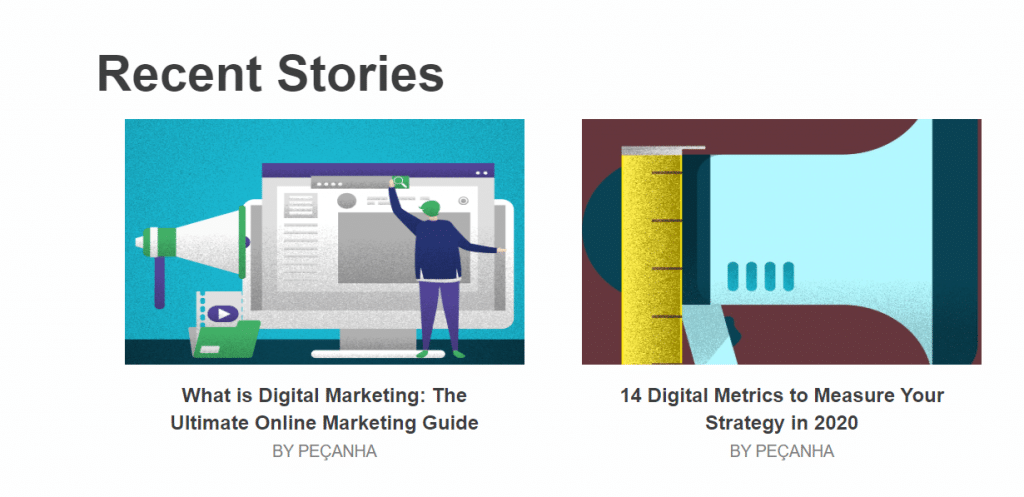
Content Marketing is also a great way to market to your intended audience.
This strategy is based on the education of the market towards the solution your company offers. Using relevant content, you can increase your clients and possible clients by educating and engaging them.
This way, they will trust in you and advocate for your brand, creating a bond of fidelity between the brand and the customer.
While most people think that written content is the only thing that companies use in content marketing, the truth is there are different types of content that you can use for Digital Marketing.
Since your entire audience is living in the information age, traditional marketing and advertising methods are not as effective as before.
Catchy quotes, eye-pleasing pictures, and incredibly detailed videos of your brand and its personality can reach them just the way you want.
#5. Affiliate Marketing

Affiliate Marketing is the type of marketing where the affiliate receives a commission on every post they promote.
So an affiliate may make multiple posts and receive payments for each of these posts, based on the sales they generate.
Anyone can be an affiliate: from customers to salespeople.
And if you wanna crossover strategies, you can join affiliate marketing with influence marketing. This way you’ll bring a new audience through the popularity of those you invited to be affiliates.
This is often an option that companies offer to smaller influencers, like smaller YouTube channels.
#6. Blog

If you have embraced Digital Marketing as a way to get to more people and turn them into clients, you know that a website is an important tool for the process.
Blogging helps a website do its job. By posting relevant content on your blog and using the appropriate keywords, your website will be on a higher page rank at any search engine.
The higher the website ranks, the more likely it is to be seen and the more traffic you will have. That means that business blogging helps with SEO.
By providing content through a blog that answers your customers’ questions and offers real solutions, you will turn traffic into qualified leads.
By doing that you are building a relationship with those leads and nurturing them through the customer journey, which we will talk about later.
#7. Email Marketing

While each of the marketing tactics mentioned has its advantages, email marketing is the king of content and brings in an unbeatable return on investment compared to other Digital Marketing strategies.
By using email marketing, you can attract and retain customers with personalized messages that promote your content, product, and brand.
In addition, you can segment contacts and use personalization techniques to deliver important messages to your customers.
The fact is that email marketing is effective and cost-efficient. Besides, this is an incredible tool that allows you to measure the results of your campaigns.
#8. Marketing Automation
Marketing automation is the key to scaling your marketing production. By using marketing automation software your department can automate basic tasks and optimize its workflow.
Email marketing, social media posting, lead generation, lead nurturing workflows, and metrics analysis can all be done with marketing automation software.
Working with these tools, your team will be able to increase sales and leads, as well as decrease the customer acquisition cost.
All of this while having more information on your clients and potential clients, mapping all steps of the buyer’s journey, and having more time to think about your marketing strategy instead of doing the manual work.
#9. Inbound Marketing
Inbound marketing is perhaps one of the most critical, relevant digital marketing strategies today, so it’s crucial that you make it part of your ongoing approach.
As a methodology, it’s about more than simply driving traffic to your website and generating leads. It’s truly about making genuine connections with your potential customers and building strong long-term relationships with them.
You do this by creating content and presenting insights that deliver genuine value to your target audience.
And how do you provide value? In one of the three following ways (or any combination of them).
- Attract: Bring your audience to you by creating content and starting conversations that position you as a trustworthy authority in your field.
- Assist: Provide your audience with solutions that either directly address their most pressing pain points or answer questions they have about a topic.
- Empower: Give your audience compassionate authority-level support that helps them make solid purchasing decisions and empowers them as consumers.
When you, as a marketer or brand representative, give a consumer what they need in the form of helpful information, genuine assistance, and authentic connection, they’re much more likely to buy from you.
In this way, inbound marketing helps your brand build serious momentum.
#10. Pay-Per-Click (PPC)
Pay-per-click (PPC) advertising has been a digital marketing mainstay for a long time and with good reason.
When approached correctly, it’s highly effective at driving high-quality traffic to your website and generating leads that are highly likely to convert.
Today, PPC ads — paid advertisements designed to accompany a variety of web experiences — can take a couple of different forms.
The one you’re likely most familiar with is the paid advertising that appears at the top of Google search results. However, advertisements that appear before YouTube videos, in mobile apps, and so forth also follow the PPC model.
One of the most significant advantages of PPC is it’s easy to scale your campaign to match your current budget since you only pay when someone clicks on an ad.
However, the actual cost of a particular campaign can vary greatly from one project to the next.
How much it will cost to run a particular ad depends mainly on how competitive your chosen keywords are, as you must bid on the key phrases you want.
But PPC as a digital marketing discipline is highly flexible. You can target consumers located anywhere globally, including local customers you want to attract through the doors of a brick-and-mortar business.
#11. Sponsored Content
Branded content is a huge deal in today’s digital marketing world for more reasons than one.
Not only does branding your content help boost ongoing brand recognition, but people tend to remember branded content roughly twice as long as they do standard content.
That’s because brands have more in common with people than you might realize, including distinct personalities, voices, and values.
So when you brand your content, you give it a unique identity that sets it apart from all the rest of the noise out there.
However, it’s not always time-effective or even desirable to produce all of your branded content yourself.
Sponsored content is content you pay an influencer or another brand to create or distribute on your behalf.
It offers you a great way to generate more of the type of branded content that delivers results and leverage other people’s followings to expose your brand to a larger audience.
Sponsored posts are most successful when you partner with companies, influencers, and other content creators who already specialize in topics that align with your brand.
The ideal result is material that is so in sync with your brand, it feels less like an ad and more like any other piece of helpful, entertaining content.
#12. Native Advertising
Native advertising is paid advertising that fits so seamlessly into the design of the surrounding media or website that it feels like it’s part of the experience.
Consider the way the ads you see while scrolling through your social media feeds look just like the rest of the posts versus how an old-school banner ad on a website sticks out as something that doesn’t quite belong.
While traditional online advertising can be jarring and disruptive to a person’s user experience, native advertising blends nicely into the editorial flow of the content around it.
It makes it easier to expose an audience to advertising without also making them feel intruded upon or otherwise interrupted.
Like other forms of paid advertising, native advertising can take many forms. One of the most popular, effective options is in-feed advertising that appears as part of the news feed flow on social media platforms like Facebook, Twitter, LinkedIn, and Instagram.
However, native ads can also occur as content suggestions at the ends of articles and promoted listings on SERPs or in sidebars.
#13. Online PR
Also known as digital PR, online PR is a digital marketing tactic focused on distributing select content to choice media outlets.
The idea is to boost coverage of a brand, company, product, or service and build that brand’s catalog of high-quality backlinks.
When a brand’s being talked about and linked to online, especially by trusted news sources and high-quality authorities, that’s a signal to search engines that it’s relevant and worth taking seriously.
An excellent online PR campaign also works wonders for building brand awareness and increasing a consumer’s likelihood of buying from that brand in the future.
Online PR differs from traditional PR in several fundamental ways. Traditional PR typically leverages standard media formats like radio, television, and print to spread the word about a brand and get people talking about it.
Since these methods tend to be less targeted than online alternatives, it can take longer to see the desired result.
Online PR tactics are more finely focused and use specially created content (like infographics, videos, articles, and interactive content) to reach specific audiences.
The results tend to manifest more quickly, and progress is much easier to measure thanks to extra-precise metrics and user-friendly tools.
#14. Instant Messaging Marketing
Over the years, instant messaging has become so much more than just another convenient way to keep in touch with friends, family, or colleagues.
It’s now a preferred means of communication for many people, including when communicating with businesses.
In fact, according to a recent survey by Avochato, nearly two-thirds of modern consumers — 63 percent — far prefer doing business with companies who offer text or instant messaging as a contact option.
Not only are instant messages and text far more in step with the amount of time modern consumers spend on their phones, but they’re also more personal.
And although text and instant messaging are both good options for companies looking to stay connected to their customers, instant message marketing has some distinct advantages.
You’re far more likely to forget about a standard SMS text you receive from a brand about a sale or special deal.
However, an instant message integrates seamlessly with the rest of a person’s social media activity, so it’s more likely to attract a response.
Plus, instant marketing messages can transition naturally into a conversation if needed or desired, making it a terrific way to establish and maintain ongoing communication.
Digital Marketing Examples
Naturally, not all digital marketing campaigns are equal. Some merely get the job done, while others absolutely knock it out of the park.
Here’s a look at some exceptionally terrific examples of digital marketing in action.
National Geographic
When it comes to publications, it doesn’t get much more recognizable than National Geographic.
This brand knows its strengths and leverages avenues like social media to use them to its advantage.
For instance, National Geographic has established quite a presence on Instagram thanks to its beautiful images and worldly take on current events.
With over 200 million followers, its account is a shining example of how to turn a free social media presence into a valuable digital marketing asset.
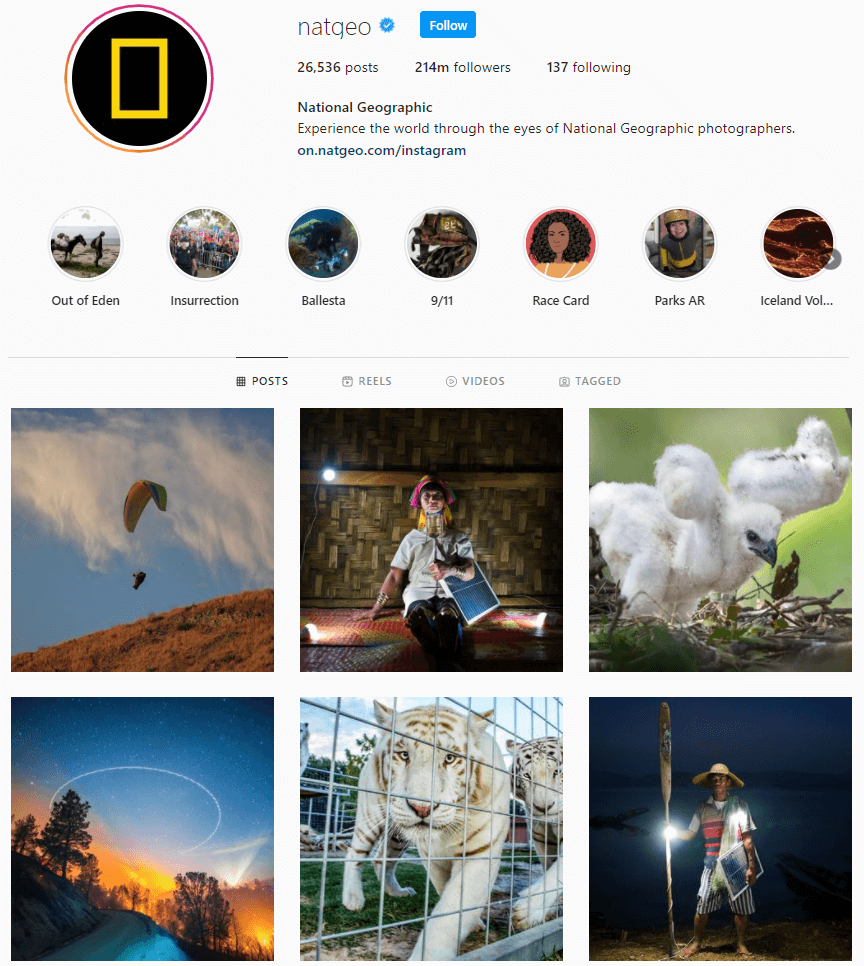
Dove
The Dove brand name is practically synonymous with concepts like authenticity, healthy self-esteem, and mindful natural beauty.
These values are further supported by intelligent digital marketing decisions.
For instance, Dove’s Reverse Selfie campaign spotlighted the impact of social media on today’s children and teens by showing the reverse of one teen girl’s selfie prep routine.
That campaign is a beautiful example of how powerful and intimate digital marketing can feel when a brand is truly in sync with its audience and gets straight to the heart of what matters to them.

Alice and Olivia
Alice and Olivia is a contemporary clothing company, so its team definitely knows its way around a modern digital marketing campaign.
The brand also happens to operate a popular blog that brings much value to its massive audience.
In other words, Alice and Olivia is a brand to watch if you want to see a stellar example of the value of digital marketing techniques at work.
Yes, it’s embraced paid advertising and other similar avenues, but its blog is where it really shines the brightest.
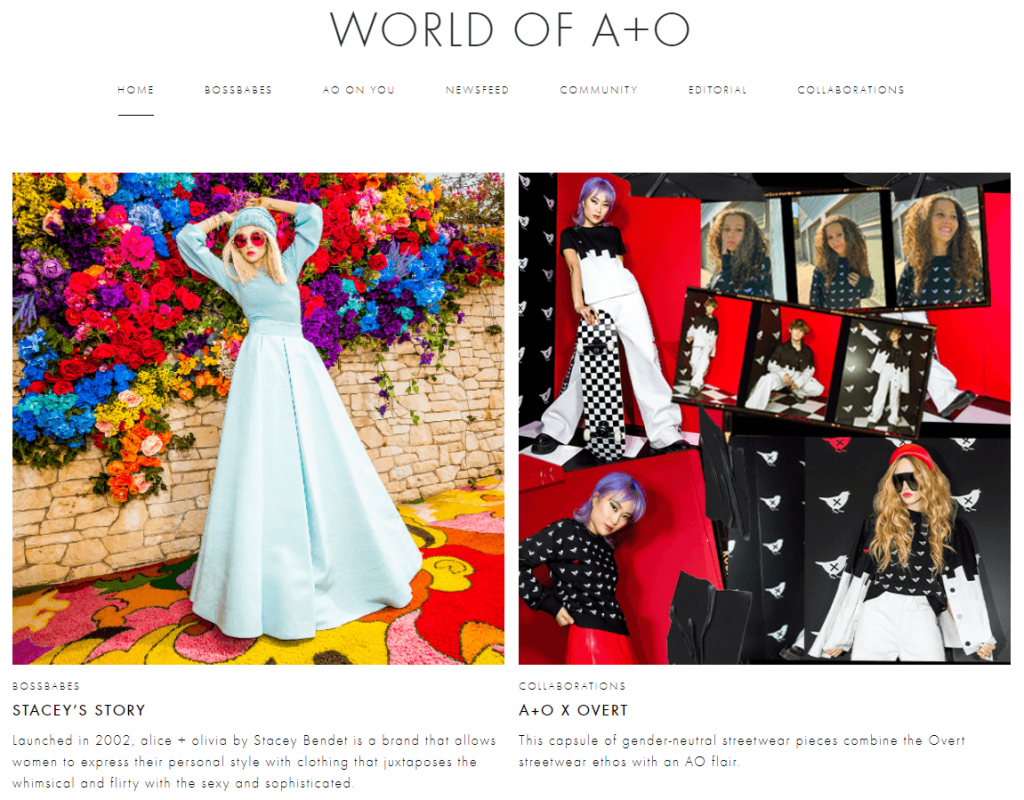
Always
Another example of a brand that’s great at creating successful individual campaigns is Always.
Take their #LikeAGirl campaign, for example. It tapped into the power of emotional marketing by asking people what does it mean to do something “like a girl”.
The idea behind the campaign was to inspire and empower an audience, and it does that very well.
However, very little of the marketing content directly mentioned the Always brand.
This helped place the ultimate focus where it belonged — on not only the values behind the brand but the women and girls who rely on Always as part of their everyday lives.

How B2B And B2C Companies Can Use Digital Marketing Strategies
These days, B2B and B2C marketing are somewhat similar. While traditional marketing methods were different for B2B and B2C companies, social media and the internet have bridged this gap.
Thanks to channels such as social media, companies can now advertise to both companies and customers alike with the same platform and the same strategies.
The difference between these strategies comes in how the company uses them and the type of content you should address them with.
The audience
The biggest difference between these two types of businesses is their target audience. This is the first thing you will have to consider when implementing a marketing strategy.
Customers in B2B businesses include business owners and managers. In other words, people that know a lot about the industry that you are operating in.
Companies will have to make sure their content does not talk down to these professionals and instead talks to them.
On the other hand, B2C companies deal with customers who know a lot about the market but do not know the intricacies of the said market.
Companies will be able to market to them in an informative way, which will help them make more educated decisions.
Another big distinction between B2B and B2C customers is that one is looking for a product or service that has plenty of utility, while the other is looking for the best value.
B2C customers are often looking for products that give them the most utility for a lower price. However, B2B customers are rarely concerned with the price of a product and look more to its functionality, versatility, and utility.
Platform and tone
Another important distinction between the B2B and B2C companies is their marketing platform.
It is safe to say that social media plays a vital role in every company’s Digital Marketing strategy. The major difference between the two comes in the platform that they are using as well as the tone they choose.
B2C companies will often choose a very friendly, inviting and often very casual tone to attract their target audience.
This tone is also a reflection of the brand’s personality, which is why it is essential to every B2C business.
These companies will also use platforms like Instagram, Facebook, Pinterest, and even Snapchat — casual and relatable social media sites — to promote their brand.
B2B companies tend to have a more serious tone and a very straightforward message. These companies use very specific social media platforms like LinkedIn and AngelList, which are all business platforms.
People who are on these sites have a business mindset, allowing you to connect with them on a more professional level.
Size of the market
The size of the market is also a major factor in both types of businesses’ Digital Marketing strategies.
B2C companies are effectively advertising to a massive market with millions of possible customers.
On the other hand, you have B2B businesses that are always catering to a very specific niche of owners and managers.
Relationship with customers
B2B and B2C companies are also very different in the relationship that they form with their target audience through their marketing.
In other words, these two different types of businesses have very different business objectives.
B2C companies are more concerned with creating brand loyalty and increasing revenue.
B2B companies have a much more specific criterion that takes higher priority over increasing revenue.
Although that is not to imply that increasing revenue is not one of their priorities, they are more focused on creating long-lasting relationships with their customers.
How to Measure Digital Marketing Success
Measuring the success of your digital marketing efforts is crucial to refining your strategy and achieving optimal results. While it can be challenging to predict what will work, tracking, analyzing, and evaluating your campaigns are essential steps.
To effectively measure your digital marketing success, it is vital to establish clear and attainable goals and identify the key performance indicators (KPIs) that will guide your evaluation.
Here are some important KPIs to consider:
Site Traffic
Monitoring overall site traffic provides a broad overview of your digital marketing performance. It allows you to assess fluctuations, identify patterns, and measure the impact of specific campaigns or marketing initiatives on overall website visits.
SERP Rankings
Search Engine Results Page (SERP) rankings indicate how well your website ranks for targeted keywords in search engine results. Monitoring your rankings helps evaluate the effectiveness of your search engine optimization (SEO) efforts and allows for adjustments to enhance visibility and organic traffic.
Unique Visitors
Tracking the number of unique visitors to your website provides insights into the reach and visibility of your digital marketing efforts. It indicates the effectiveness of your campaigns in attracting new visitors and expanding your audience.
Bounce Rate
Bounce rate measures the percentage of visitors who navigate away from your website after viewing only one page. A high bounce rate may indicate issues with website design, content relevance, or user experience, requiring optimization to enhance engagement and encourage further exploration.
Conversion Rate
Conversion rates measure the percentage of visitors who take a desired action, such as making a purchase, signing up for a newsletter, or completing a form. Monitoring conversion rates helps gauge the effectiveness of your marketing funnel and the ability to turn visitors into customers or leads.
Inbound Links
The number and quality of inbound links to your website play a crucial role in search engine optimization (SEO) and online visibility. Tracking inbound links helps assess the success of your content marketing efforts, as well as the credibility and authority your website holds in the digital landscape.
Remember that the selection of KPIs should align with your specific goals and objectives.
Regularly reviewing and analyzing these metrics will provide valuable insights into the effectiveness of your digital marketing strategy, enabling you to make data-driven decisions and optimize your campaigns for better results.
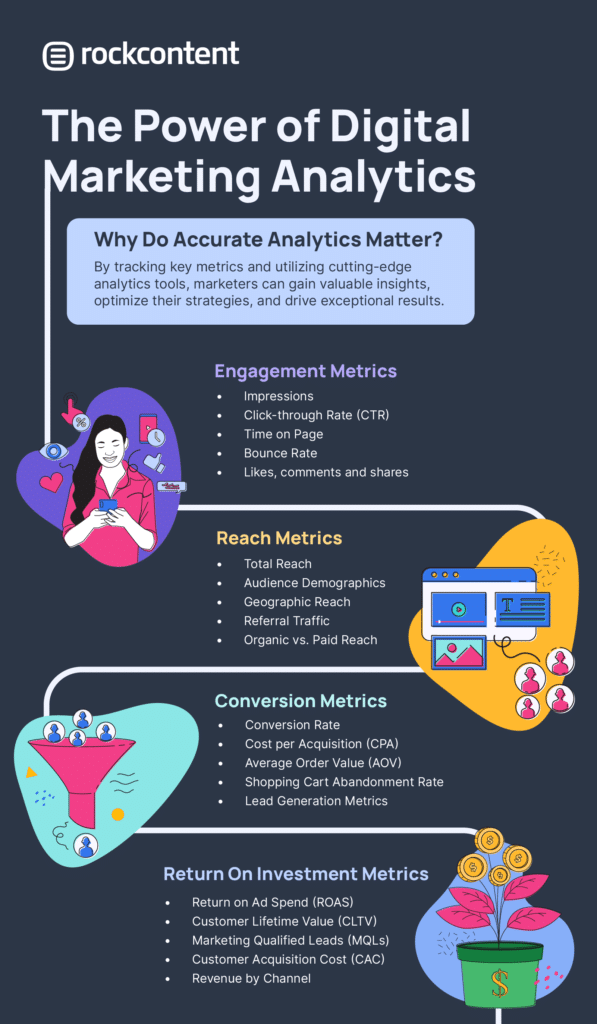
Popular Digital Marketing Tools
Digital marketing tools can help you save time and money. They can also increase the efficacy of your campaign.
There are tons of digital marketing tools to choose from. Even so, some are better than others. Here are some excellent options that stand out from the crowd.
Content Cloud
Content Cloud is a platform offering several digital tools and services. It’s run by Rock Content, a successful marketing agency with over ten years of experience.
Content Cloud includes WriterAccess, which connects you with vetted freelance content writers, editors, and designers who can create any type of content. Stage, another tool on the platform, publishes your content and boosts its visibility.
Ion is a tool for creating engaging, interactive content without coding. Studio makes it easy for team members to collaborate on digital marketing projects.
You can use any of these tools separately. However, using the complete package provides you with everything you need to create a winning digital marketing campaign.
MailChimp
MailChimp is one of the world’s best-known email marketing platforms. It’s used by millions of businesses and offers great tools to help you segment your audience. It sends automated emails at pre-selected times or based on consumer actions.
Even so, MailChimp isn’t only for building a winning email marketing campaign. It can help you build an appealing, efficient, optimized website. You can use it to create personalized pop-up messages for people who come to your website.
MailChimp also has a campaign management platform to help you manage your digital marketing campaign. It’s a handy tool for analyzing ad performance on various platforms. It can also monitor ad engagement, user actions, and sales.
Creatopy
Users remember visual content better than only text. Adding color, graphics, and animations to your digital marketing arsenal can improve your ROI.
Creatopy has everything you need to create engaging, appealing ads. You can use it to design social media ads, video ads, display ads, and more.
The site has a vast range of templates to suit the needs of any industry. It also offers plenty of stock images and audio files to pick from. Other tools include a video editor, PSD editor, image resizer, feed ad builder, and ad serving.
Botsify
AI tools can improve a user’s experience on your site. They can also help you get to know site visitors and identify the ones most likely to become customers.
Botsify offers chatbots that can converse with customers 24/7. These bots can help people find products and answer questions. They can even remind customers about special deals and abandoned shopping carts.
Botsify is also ideal for generating qualified leads. It can help you see what people need to complete a purchase. You can then target your advertising to meet the need and make the sale.
What’s more, Botsify doesn’t create one-size-fits-all chatbots. It allows for custom creation. You can personalize your chatbots and AI tools to suit your exact business requirements and consumer needs.
Google Analytics
Google Analytics offers a gold mine of information for any data-driven digital ad campaign. What’s more, it’s 100% free.
Do you want to know what days and times most people visit your site? Would you like to see which geographic locations your site visitors come from? Google Analytics answers these questions and more.
Analytics can show you exactly how users interact with your site. You’ll see what they look at, which links they click, and what they buy. It can show your top-selling products and conversion rate for advertisements.
Google Analytics also shows information to help you improve your web design. This includes your bounce rate and load speed for your site. Additionally, it shows which devices people use to access your site.
What Does a Digital Marketer Do
Even though Digital Marketing might seem easy in theory, it is quite complicated and requires a lot of knowledge as well as experience.
If you feel like having to learn the ins and outs of digital marketing is too much for you, then hiring a digital marketer might be just what you need.
A digital marketer — or a Digital Marketing Manager — is responsible for crafting a marketing strategy, as well as implementing and managing it.
These marketers have plenty of experience in their respective fields and can bring in an impressive amount of leads or customers to your business.
They use training and experience to find the most suitable marketing channels to promote your brand and products.
To put it simply, a digital marketer is responsible for the success of your Digital Marketing campaign.
They will accomplish the goals of the campaign while keeping in mind budgetary restrictions and other important aspects of the business.
They will also use their knowledge and experience to decide the best strategy to adopt for promoting a specific brand or product.
Although a marketing manager can be quite a lifesaver in certain situations, not every marketing manager may know what they are doing.
So if you are looking to outsource your Digital Marketing, here are a few tips on what to look for in a proper marketing manager.
What to look for in a good Digital Marketing manager
Digital Marketing can be quite challenging, especially when you are new to the whole affair.
You can learn a lot about Digital Marketing through online resources, courses, and training, but nothing quite matches the experience and knowledge that a dedicated professional has.
Professional marketing managers see that your strategy is successful throughout, with minimal expense.
However, you cannot just choose someone that claims to be an expert in Digital Marketing, which is why you should know exactly what to look for in a good digital marketer.
Here are traits that make for a great digital marketer:
Can use analytics and data effectively
One of the core characteristics of a good digital marketer is that they can use various quantitative data to their advantage.
Since the internet is completely based on numbers and algorithms, a good digital marketer will track the results of their strategy.
This means that they can actively track the success of their marketing strategy and make changes accordingly.
In other words, it is by keeping track of the performance of the strategy that digital marketers will gather data to their advantage, allowing them to make well-informed decisions.
Are true leaders
Digital marketers are much more than managers of your Digital Marketing campaign; they are proper leaders in their own right.
Since they will be leading an entire marketing team, they must have proper leadership skills as well as qualifications to lead your team.
Most importantly, they should be able to communicate their ideas very clearly with the rest of the team.
They should be understanding and sympathetic towards problems that their team members may be facing and should help them in overcoming such issues.
Finally, by setting up tangible goals and making sensible and fair decisions, they should be able to easily promote your brand most effectively.

Digital Marketing Services
The most common digital marketing services include SEO, social media ad management, content marketing services, and email marketing services. Other popular services are web development, link building, and conversion optimization.
You’ll likely need most or even all of these digital marketing services to grow your business. SEO helps you earn (or retain) a high rank for relevant search engine queries. Content creation boosts your SEO and conversion rate.
Social media ads and email marketing help you reach your audience with custom content. This increases your conversion rate. It also builds brand loyalty that keeps people coming back to your business.
However, you don’t have to focus on all digital marketing services simultaneously. For example, if you recently started a new blog, you’ll likely want to focus on content creation and marketing. This helps you establish yourself as a thought leader in your industry.
On the other hand, web development may be in order if your site’s bounce rate is too high. Alternatively, you may need social media ad management if you’re promoting a new product or service.
Companies specializing in digital marketing services can help you identify what you need. They can also do the hard work of creating and managing your digital marketing campaigns.
Outsourcing your marketing team
If your digital marketing isn’t getting the necessary results, bringing in the experts might be a good idea. At the same time, even effective campaigns benefit from outside help.
Outsourcing your marketing gives you the time you need to focus on other essential aspects of running a business.
Does accessing multiple services on a single platform sound like a good idea? Would you like to work with a firm with a very successful track record? If so, Content Cloud may be just the tool you’re looking for.
Content Cloud is powerful, affordable, and easy to use. Its features and services are designed to meet the needs of any business in any industry. Talk to one of our experts today to discover how Content Cloud can help your business reach its full potential.
[BONUS] The Basics of Digital Marketing For Beginners — A Summary of The Main Points
Are you just starting and want to learn the basics of digital marketing for beginners? This step-by-step guide gives you the practical knowledge you need to start today.
Digital marketing can seem overwhelming, especially with numerous self-proclaimed “experts” out there. However, this guide will help you understand the fundamentals and set you on the path to success, whether your business is online or local.
What Are The Basics In Digital Marketing?
You don’t need to know how to code a website or optimize Google display ads right away. Here are some essential strategies to get you started:
- Creating a Website: Your digital storefront.
- Building an Email Marketing List: Connect with potential customers.
- Optimizing Content for Search Engines: Increase your visibility.
- Launching Display Ads: Use platforms like Google or Bing.
- Engaging on Social Media: Platforms like Facebook, LinkedIn, and Instagram.
- Using Location-Based Targeting: Attract local customers.
These basics will build a solid foundation for your future digital marketing efforts.
Is Digital Marketing Easy?
Digital marketing can be both simple and complex. At its core, it’s about connecting people with brands meaningfully. Creating a website and adding compelling content might sound easy, but it requires continuous effort and expertise to optimize and maintain these elements for the best results.
What Are The Key Types of Digital Marketing?
Digital marketing is multifaceted, encompassing various strategies. Here’s a comprehensive list of the main types:
- Content Marketing: Creating valuable, relevant content to attract and engage your target audience. This includes blogs, videos, podcasts, infographics, and more.
- SEO (Search Engine Optimization): Enhancing your website’s visibility on search engines through on-site, off-site, and technical optimization techniques.
- SMM (Social Media Marketing): Using social media platforms to promote content and engage with audiences through both organic and paid strategies.
- SEM (Search Engine Marketing): Increasing visibility on search engines through paid advertisements and optimization techniques. This includes both SEO and PPC (Pay-Per-Click) ads.
- Paid Advertising: Using various forms of online advertising like Google Ads, Facebook Ads, and other social media ads to drive traffic and conversions.
- Email Marketing: Using email campaigns to communicate with prospects and customers, offering personalized content and promotions to drive engagement and sales.
- Affiliate Marketing: Partnering with businesses or individuals to promote products and earn commissions on sales generated through their referrals.
- Influencer Marketing: Leveraging influencers’ reach and credibility to promote products or services to their followers.
- Mobile Marketing: Reaching audiences on their mobile devices through SMS, app-based advertising, and mobile-optimized websites.
- Video Marketing: Using video content to engage audiences on platforms like YouTube, social media, and websites.
Understanding the 5 Ps of Digital Marketing
The 5 Ps of Digital Marketing adapt and expand on the traditional marketing Ps to address the unique characteristics and opportunities presented by digital platforms:
- Product: In digital marketing, product considerations still involve the core offerings but also extend to digital products, software, apps, and online services. It includes user experience (UX) design, features, updates, and customer support through digital channels.
- Price: Digital marketing pricing strategies often include digital pricing models such as subscriptions, freemium models, pay-per-click (PPC), cost-per-action (CPA), and cost-per-impression (CPI). It also involves dynamic pricing and digital marketing tools for price optimization.
- Place: The concept of place in digital marketing focuses on digital distribution channels, such as websites, e-commerce platforms, mobile apps, and digital marketplaces. It includes considerations for online visibility, search engine optimization (SEO), and digital storefront optimization.
- Promotion: Digital promotion includes all forms of online communication and engagement with potential and existing customers. This encompasses digital advertising (PPC, display ads), content marketing, social media marketing, influencer marketing, email marketing, and search engine marketing (SEM).
- People: In digital marketing, the people P refers to both the customers (target audience) and the digital marketing professionals who manage and optimize digital marketing campaigns. It emphasizes customer segmentation, personalization, customer journey analysis, and data-driven decision-making.
Digital Marketing versus Traditional Marketing
While both aim to reach audiences, digital marketing offers broader reach and interaction through various channels like social media, blogs, and email, whereas traditional marketing relies on physical media like newspapers and TV.
Tips for Beginners
- Understand Brand Awareness: Recognize the importance of brand awareness and how to build it.
- Learn SEO Basics: Start with simple SEO techniques like keyword research and link-building.
- Discover Your Brand’s Online Potential: Explore online opportunities for webinars, courses, and more.
- Know Your Customers: Conduct market research to understand your audience.
- Build a Social Media Presence: Engage with your audience on social media platforms.
Digital Marketing Courses for Beginners
If you’re feeling overwhelmed, consider taking online courses to boost your skills:
- Google’s Fundamentals of Digital Marketing: Offers 26 modules and over 40 hours of learning.
- LinkedIn’s Digital Marketing Foundation Course: Covers everything from SEO to future digital marketing trends.
- HubSpot’s Digital Marketing Certificate: Provides comprehensive training from a top digital marketing brand.
What Is Digital Marketing FAQ
Here are some of the main questions on digital marketing asked online.
What is digital marketing in simple words?
Digital marketing refers to promoting and selling products or services using online platforms and digital technologies. It encompasses various tactics such as social media marketing, email marketing, search engine optimization (SEO), and pay-per-click (PPC) advertising to reach and engage with potential customers.
What does a digital marketer do?
A digital marketer develops and implements strategies to promote a brand, product, or service online. Their tasks may include creating content for social media, managing email campaigns, optimizing websites for search engines, running online ads, analyzing data to measure campaign success, and engaging with the target audience through various digital channels.
What is an example of digital marketing?
One example of digital marketing is a company using Facebook ads to target specific demographics based on interests and behaviors, aiming to increase website traffic and sales conversions. Another example is a business optimizing its website content with relevant keywords to rank higher in Google search results (SEO).
Is digital marketing easy for beginners?
Digital marketing can be learned by beginners, but it requires understanding digital tools, platforms, and strategies. The field is dynamic and requires continuous learning to stay updated with industry trends and best practices.
Can I start digital marketing with no experience?
Yes, you can start learning digital marketing with no prior experience. Many resources such as online courses, tutorials, and certifications are available to help beginners grasp the fundamentals. Practical experience gained through personal projects or internships can also be valuable.
Can you start digital marketing with no money?
Yes, you can start digital marketing with minimal investment. Many digital marketing tactics like social media marketing and content creation can be started with little to no cost. However, for more advanced strategies like paid advertising, a budget may be necessary to see significant results.
Do digital marketers get paid well?
Digital marketers can earn competitive salaries based on their skills, experience, and the industry they work in. Entry-level positions may have varying salaries, but as digital marketers gain expertise and demonstrate results, they can command higher pay. Additionally, freelance digital marketers often have flexibility in setting their rates based on their skills and client demand.
Wrap Up
Now that you fully understand why digital marketing is important and how to create winning strategies that will help you meet your goals, it’s time to assemble the resources you’ll use to get where you need to be.
Great content that stands out, speaks to the values of your target audience, and is perfectly optimized to appeal to search engines is crucial. And you’ll need plenty of it to make the impact you want to.
Take a big step in the right direction when you assemble a team of expert copywriters and content writers to help you. Sign up for a free WriterAccess two-week trial today, and meet your future dream team!



